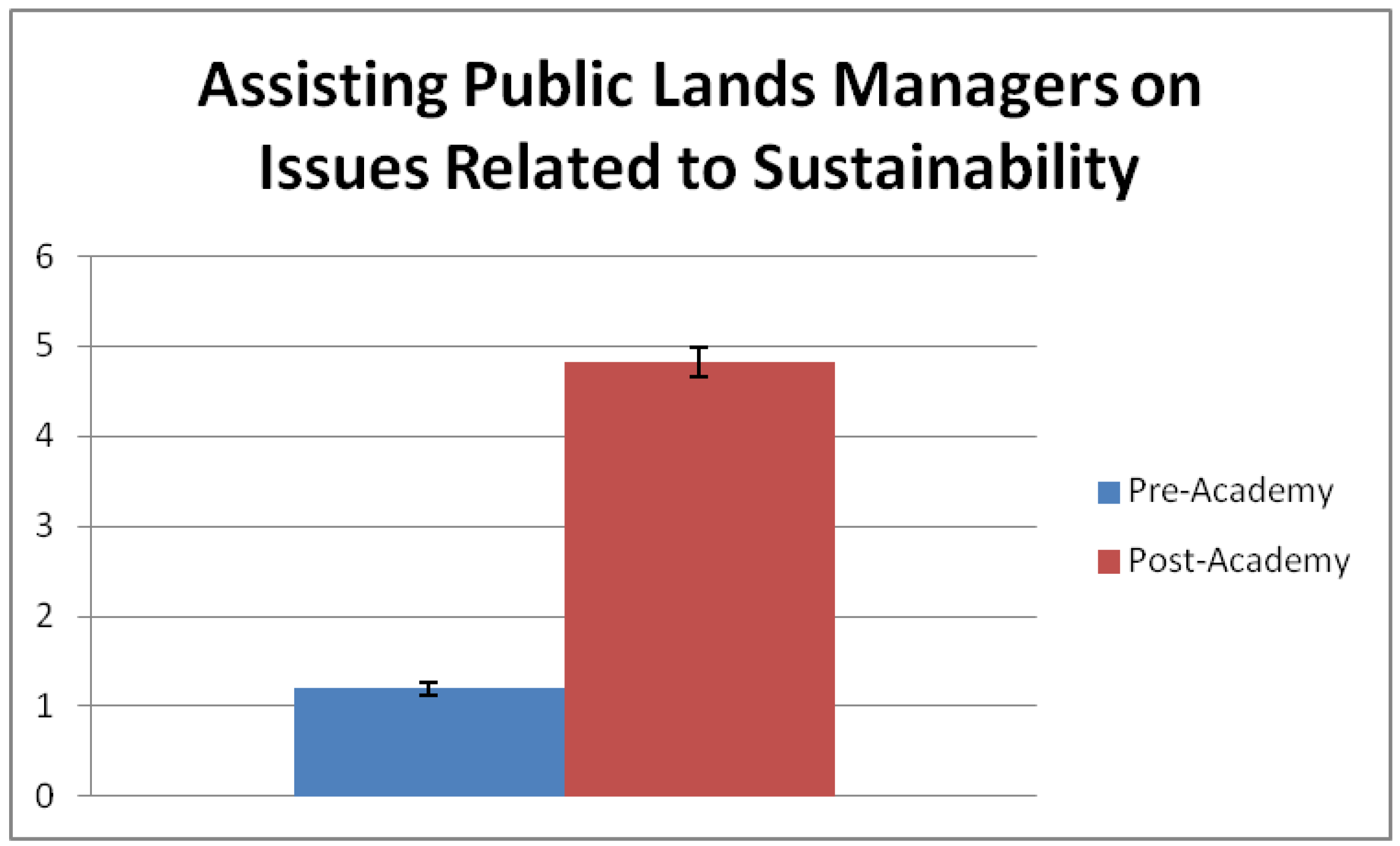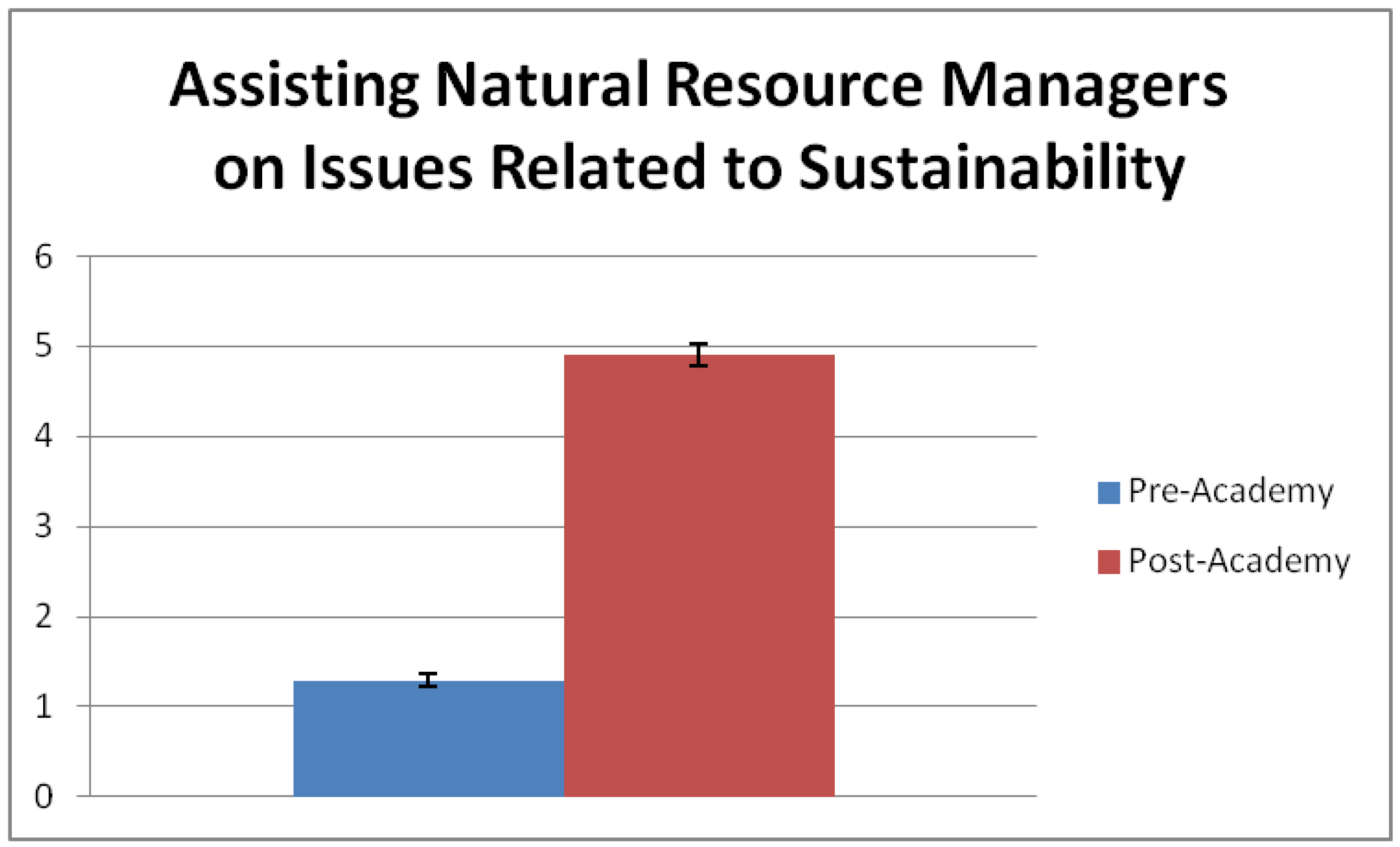Educating the Future of Sustainability
Abstract
:1. Introduction
| Climate Science (1 field lecture; 1 field discussion) | (1) Day hike to Teton Glacier System(2) National Phenology Network Field Exercise |
| General Ecology/Species Identification (daily short trips) | Bird and wildlife watching around the Jackson Valley using species identification guides and taxonomic keys |
| Environmental Science (field lecture) | Field: Greater Yellowstone-Teton representative ecosystems |
| Organizational and Leadership Science (workshop) | Meyers-Briggs Type Indicator Assessment and relation to STEM leadership roles; KGI–Team Assessment |
| Environmental Communications and Public Policy (discussion and workshop) | Communications Exercise with Madden (former CO State Climate Change Advisor and CO State House Majority Leader) and Trujillo (Communications Director for Senator Udall) |
| Cultural Anthropology (2 field trips) | (1) Field: Several native cultural sites including one active archaeological excavation; (2) National Museum of Wildlife Art |
| Watershed Management and chemistry (1 field lecture; 1 field trip) | Field trip to Jackson Lake and Gros Ventre Hot Springs |
| Geology (1 field lecture; 1 field trip) | Field: Gros Ventre Landslide and Lower Slide Lake |
| Microbiological Ecosystems (1 field lecture; 1 field exercise; 1 laboratory exercise) | (1) Field sampling exercise at Kelly Warm Springs; (2) Laboratory Culture Exercise using field samples from Kelly Warm Springs. |
| Sustainable Energy (1 lecture; 2 field experiences) | Visit proposed sites for Jackson Wind Farm and Jackson Hydroelectric |
| Academic Institutions | |
| Autonomous University of the Yucatan | Colorado State University |
| George Washington University | Institute of American Indian Arts |
| Metropolitan State College of Denver | University of Colorado, Boulder |
| Michigan Technological University | University of Colorado, Denver |
| Texas A&M University | University of Nairobi |
| Salish Kootenai Tribal College | University of Wisconsin, Whitewater |
| University of Montana | University of Wollongong |
| University of Wyoming | University of Northern Colorado |
| Utah State University | University of New Haven |
| Agency Partners | |
| Bureau of Land Management | National Park Service |
| United States Geological Survey | Rocky Mountains Cooperative Ecosystems Studies Unit |
| Organizational Partners | |
| American Museum of Natural History | Association for Advancement of Sustainability in Higher Education |
| National Phenology Network | Student Conservation Association |
| Wyoming Conservation Association | |
2. Methods
- (1)
- I can clearly define sustainability as it applies to natural resources.
- (2)
- I can clearly define sustainability as it applies to public lands.
- (3)
- I can clearly define sustainability as it applies to climate change.
- (4)
- I can effectively assist public lands managers on issues related to sustainability.
- (5)
- I can effectively assist natural resource managers on issues related to sustainability.
3. Results and Discussion
3.1. I Can Clearly Define Sustainability as It Applies to Natural Resources

3.2. I Can Clearly Define Sustainability as It Applies to Public Lands

3.3. I Can Clearly Define Sustainability as It Applies to Climate Change

3.4. I Can Effectively Assist Public Lands Managers on Issues Related to Sustainability

3.5. I Can Effectively Assist Natural Resource Managers on Issues Related to Sustainability

4. Conclusions
Acknowledgments
Author Contributions
Conflicts of Interest
References
- West, J.; Julius, S.; Kareiva, P.; Enquist, C.; Lawler, J.; Petersen, B. U.S. Natural resources and climate change: Concepts and approaches for management adaptation. Environ. Manag. 2009, 44, 1001–1021. [Google Scholar] [CrossRef]
- Bowser, G.; McLaughlin, S.; Brown, M.A. Engaging underrepresented minorities in the sciences. In Rethinking Protected Areas in a Changing World: Proceedings of the 2011 GWS Biennial Conference on Parks, Protected Areas, and Cultural Sites; Weber, S., Ed.; The George Wright Society: Hancock, MI, USA, 2011; pp. 48–53. [Google Scholar]
- Davis, E.; Bowser, G.; Brown, M. Creating the global leader and global mind-set: Engaging multicultural students in multidimensional learning. In Environmental Leadership: A Reference Handbook; Gallagher, D.R., Ed.; SAGE Publications: Thousand Oaks, CA, USA, 2012; pp. 891–899. [Google Scholar]
- Kolb, A.Y.; Kolb, D.A. Learning styles and learning spaces: Enhancing experiential learning in higher education. Acad. Manag. Learn. Edu. 2005, 4, 193–212. [Google Scholar] [CrossRef]
- Lewis, L.H.; Williams, C.J. Experiential learning: Past and present. New Dir. Adult Contin. Edu. 1994, 1994, 5–16. [Google Scholar] [CrossRef]
- Bandura, A. Self-efficacy: Toward a unifying theory of behavioural change. Psychol. Rev. 1977, 84, 191–215. [Google Scholar] [CrossRef]
- Rebman, C.M.; Kelly, D.; Ogedengbe, F.A. A new model for measuring instructional effectiveness and student learning in the classroom. Issues Inf. Syst. 2013, 14, 298–305. [Google Scholar]
- Pajares, F. Self-efficacy beliefs in academic settings. Rev. Edu. Res. 1996, 66, 543–578. [Google Scholar] [CrossRef]
- Cabrera, A.; Collins, W.; Salgado, J. Determinants of individual engagement in knowledge sharing. Int. J. Hum. Resour. Manag. 2006, 17, 245–264. [Google Scholar] [CrossRef]
- Schunk, D.H. Self-regulation of self-efficacy and attributions in academic settings. In Self-Regulation of Learning and Performance: Issues and Educational Implications; Schunk, D.H., Zimmerman, B.J., Eds.; Erlbaum Publishing: Hillsdale, NJ, USA, 1994; pp. 75–99. [Google Scholar]
- Multon, K.D.; Brown, S.D.; Lent, R.W. Relation of self-efficacy beliefs to academic outcomes: A meta-analytic investigation. J. Couns. Psychol. 1991, 38, 30–38. [Google Scholar] [CrossRef]
- Bandura, A. Social Foundations of Thought and Action: A Social Cognitive Theory; Prentice Hall: Englewood Cliffs, NJ, USA, 1996. [Google Scholar]
- Bandura, A. Self-Efficacy: The Exercise of Control; Freeman Publishing: New York, NY, USA, 1997. [Google Scholar]
© 2014 by the authors; licensee MDPI, Basel, Switzerland. This article is an open access article distributed under the terms and conditions of the Creative Commons Attribution license (http://creativecommons.org/licenses/by/3.0/).
Share and Cite
Bowser, G.; Gretzel, U.; Davis, E.; Brown, M. Educating the Future of Sustainability. Sustainability 2014, 6, 692-701. https://doi.org/10.3390/su6020692
Bowser G, Gretzel U, Davis E, Brown M. Educating the Future of Sustainability. Sustainability. 2014; 6(2):692-701. https://doi.org/10.3390/su6020692
Chicago/Turabian StyleBowser, Gillian, Ulrike Gretzel, Elizabeth Davis, and Mark Brown. 2014. "Educating the Future of Sustainability" Sustainability 6, no. 2: 692-701. https://doi.org/10.3390/su6020692





